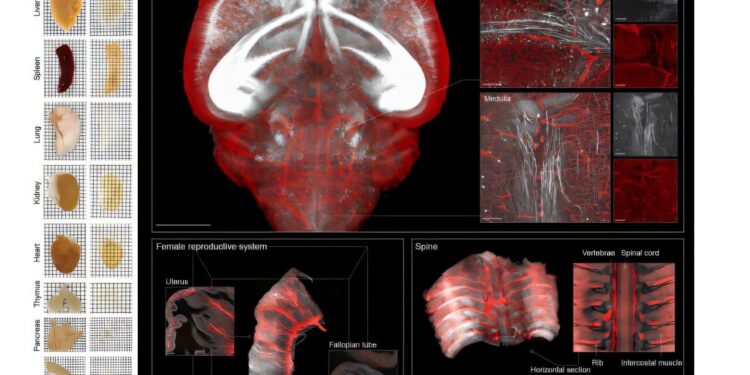Vivit allows the transparent of whole organs with strong morphological fidelity. Credit: Cell (2025). DOI: 10.1016 / J.Cell.2025.07.023
Scientists have found a way to visualize delicate organs such as the brain and the heart, letting light enter the tissues and by exposing their internal functioning, no dissection required. In their study published in CellChinese researchers introduce a new technique to convert biological fabric into a transparent and glass state, which facilitates the visualization of the way biological tissues interact with each other at a microscopic level with an exceptional resolution.
To obtain a transparent structure, the researchers have developed a technique called volumetric inspection based on ionic solvents-glass liquids of the biostructure or vivit on a trans scale.
The stars of the show were ionic liquids (it), which are salts which tend to exist in liquid phase even at lower temperatures. Using Vivit, researchers have mapped how multisensory neurons in the brain region of the brain connect to their incoming signals and target their brain -scale outings, as well as new information on the inhibitory control of the human cortex.
Understanding the complex biological systems requires visualizing their complex structures and mechanisms closely and in detail. Techniques such as the optical fabric compensation allow scientists to imagine tissues in their 3D state, which means that whole organs can be seen without cutting them.
However, most of these methods use organic solvents or aqueous solutions to make the tissues transparent, which performs the task but sees with their own disadvantages. These liquids can cause tissue or swelling, including the natural shape of the tissues.
The researchers of this study revealed that the treatment of organic samples with them initiated a process called vitrification where the tissues have turned into a structure into solid glass without forming destructive ice crystals when cooled.
Adapt the biological tissues to the IL and allow the transparent retained by the morphology with the improvement of the FP signal. Credit: Cell (2025). DOI: 10.1016 / J.Cell.2025.07.023
This non -destructive nature makes a revolutionary method of vivit, because it preserves delicate biological samples while allowing the team to visualize structures through the scales – whole organs with the most beautiful cellular connections.
Biologists often use high -resolution microscopy to better look at structures in organic tissues. These microscopy machines do not work well with whole organ samples and therefore require samples in thin slices to reach clear images. This process damages the fine structure and makes it difficult to reconstruct precise 3D models from multiple slices.
Vivit solves this problem by making the sample optically clear, thus providing a practical means of studying biological structures without physically cutting the fabric. It also preserves the capacity to cut the samples precisely in a frozen state without causing damage, thanks to the protective effects of vitrification.
An additional advantage of vitrification is its unexpected improvement in fluorescent dye signals, increasing the brightness up to 38 times for certain dyes, considerably improving high -resolution imaging.
The team has also developed TARR (reconnection system and reconstruction of acquisition on a trans-scale scale), a software tool which practically covers samples decided in a 3D structure with high fidelity.
The researchers note that if Vivit offers a practical solution for the interrogation on a trans scale, it remains necessary to clarify the mechanisms by which it interact with the suitable tissues, to induce non -crystal states and to amplify the fluorescence signals. These ideas can inspire the development of more recent methodologies based on IL to study complex biological systems.
Written for you by our author Sanjukta Mondal, edited by Sadie Harley, and verified and revised by Robert Egan – This article is the result of meticulous human work. We are counting on readers like you to keep independent scientific journalism alive. If this report matters to you, please consider a donation (especially monthly). You will get a without advertising count as a thank you.
More information:
Yixiao Gao et al, Vivit: resolution of volumetric biological architectures on the scale transmitted via the ionic glass fabric, Cell (2025). DOI: 10.1016 / J.Cell.2025.07.023
Newspaper information:
Cell
© 2025 Science X Network
Quote: Ionic liquids become transparent whole organs such as glass while preserving the details of complex tissues (2025, August 20) recovered on August 20, 2025 from
This document is subject to copyright. In addition to any fair program for private or research purposes, no part can be reproduced without written authorization. The content is provided only for information purposes.



